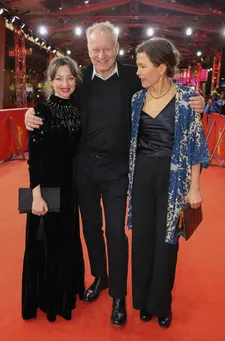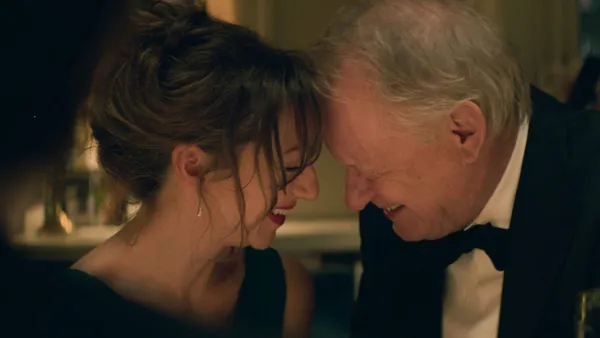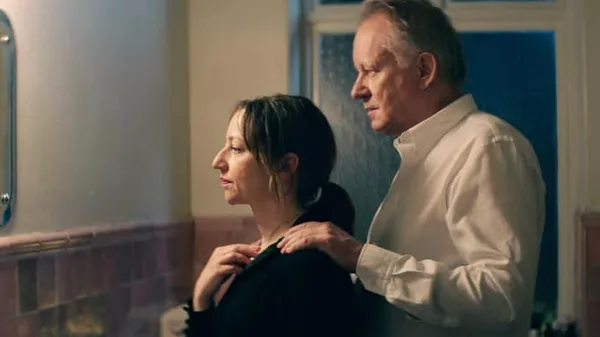Writer/director Maria Sødahl's auto-fiction film Hope finally comes to UK cinemas this week, more than two years after it premiered at Toronto Film Festival back in 2019. Sødahl draws on her own experience of being diagnosed with a brain tumour to tell the story of Anja (Andrea Bræin Hovig) and Tomas (Stellan Skarsgård) - a couple with a blended family, as their relationship and world shifts on their axes as a result. As Sødahl explained in this interview - taken back when the film screened at Berlin Film Festival in 2020 - this is a film that is about love and life rather than cancer and death. It is being released with perfect timing to coincide with the period covered by the film.
Amber Wilkinson: It’s such a personal film. What did your family think when they saw it? Because it's one thing to be agree on paper to be involved in the project. But it could be different in practice.
Maria Sødahl: Of course, it's an ethical thing and it's complex, in so many layers. So the transparency of when you're in the process, writing, etc. And then knowing your writing, and my husband, who's a director as well. We always help each other. At the same time, I was very clear that this is my point of view – and I can't tell your point of view. So it's tricky. And with the kids, it was not like portraying you and you and you, it was about portraying an organism, a blended family – the energy of it and the playfulness of it. The kids read the scripts, the shooting script, and then they see in almost really edited them, and they have three weeks afterwards, you know, and they can come with comments. These were the rules, kind of. That said, I would never have made this movie if I didn't have a good relationship. And that's the story as well, it’s something which comes to a happy end in a way and a possible new start of something for the audience. I can tell you about the process but how they reacted to everything afterwards, that’s their story and that belongs to them.
 |
| Andrea Bræin Hovig, Stellan Skarsgård, Maria Sødahl on the Berlinale red carpet Photo: Courtesy of Berlinale |
AW: How do you feel when you finally sort of saw it coming together? Was it cathartic or was it just a relief to finally get to the end of a very long process?
MS: After having written everything, which was more therapeutic in a sense, I was so afraid that the film would end up being therapeutic. But I sort of left that behind. And then I was very, very professional. I needed that distance myself. I needed to make a fiction I needed to make a couple who had their own odd couple traits. So, to me, it was a fiction in a much stronger degree.
AW: It must help when you go to the casting process, because then you can cast people who don't look like you or whatever. I assume that that sort of helps you to add a bit of distance.
MS: Yes. I wanted that. I wanted to have an X Factor. I wanted to be have gifts, which were not there, different layers, because of different characters.
AW:Did you have cast in mind when you came to the project?
MS: Stellan was there very early, because I couldn't think about any other Scandinavian actor who could defend this character in a good way, as somebody who had that inner life, and who could be defending somebody who's not only silent because of helplessness towards somebody who's dying, but also because of respect. So to have this kind of dignity. So it's balanced there, who could feel that silence with all sorts of different content.
I had no idea who Anja was, as an actress. And I had been away because of this story, for seven years, so starting the casting process, I really wanted to be open and I wanted to see every Norwegian film actress from 40 to 51 - to see what had happened to them. I didn't her exact age, it was all about the character. So I did one heavy scene with all of them and from there, I chose Andrea Bræin Hovig.
She has this energy, which is, can go in so many directions and she's a very good comedian, which is very important. And to avoid sentimentality, which is my primary goal - to not make sentimental cancer movie. It's a love story and not a cancer story at the end of the day. And it’s a love story in the sense of modern love, which is a theme that interests me and looking back to see who we were and what this was about. It was not about finding a way back to a love we had, it's about finding a mature love.
AW: You touch on the idea of the way that when you've been in a relationship for quite a while, you sort of reflexively do things for one another in a way that can lead you to be touching on somebody, maybe more easily than actually reaching out to them – as when Tomas does the clasp up on Anja’s necklace.
MS: Yes. Absolutely. It’s a story about a couple of who start here, having lived parallel lives. And I think that the countdown in a way in the movie, which is this very 10 days, was a gift from reality, with the hospitals closed down in the first days. They start so far apart from each other. The love story becomes obvious in the middle of the movie, as it's a medical story to that point, and they're not aware that they're part of a love story. Yes, as she says, her will is just to be able to help each other that the kids should see and remember that their parents were able to help each other in the situation. It’s not about loving each other but helping each other and then it turns into a love story.
 |
| Maria Sødahl: 'The love story becomes obvious in the middle of the movie, as it's a medical story to that point, and they're not aware that they're part of a love story' |
AW: It's interesting, because you don't forget the kids, which is I think one of the stronger elements in the film. A lot of films would become narrower, almost as they went along, as the romance would build. But your film actually stays quite broad in terms of considering the emotions that are running around the couple, as well as the emotions between themselves. Were you keen to keep that tapestry?
MS: Yes. Because I think the biological and stepchildren and all this are so important in her life, and it's about life, and it's not about death. So the more life feels good, the more it makes the death threat even more present because that's everything that she's going leave. Everyone can relate to that. She's aware of this. And she's also so self-absorbed in this dying.
AW: So having done this super-personal project, how do you go forward from that? Have you been working on other things at the same time?
MS: It’s special with this one, because I was so ill. This project has been all been being a test rabbit in my own laboratory, you know, seeing: Can I do this, first writing? Can I pull this together? Because writing is more challenging than directing. Directing is analytic and very practical and you got lots of assistance. Writing is like keeping, you know, everything here. And so having had brain cancer and treatment for that, I could only work one hour per day, for a very long time. So step by step, I didn't think I was able to direct so you know, the first thing was could I make this in a good way, present it to a producer, get finance? Get insurance? But I had money for a project earlier on, which was a love story with a couple with a huge age difference. But it was a concept. So that went into writing this one, which I’ve now made. Now I’ve been working for a year on a new project about a 19 year old in educational travel. In the 18th century, you sent upper-class children to learn about other cultures. I did this in the Eighties, in Mexico, I was 18 years old, doing this alone in machismo country there. It’s about finding identity and when you travel along you can play with your identity and it's very tempting. I think it's so interesting, this being so naïve, and with so much blind courage.
Hope is on release in Picturehouse cinemas from December 10.
- Read Stellan Skarsgård on the importance of life and hope
- Andrea Bræin Hovig on differing expectations, translating ideas, and Hope
Share this with others on...






















